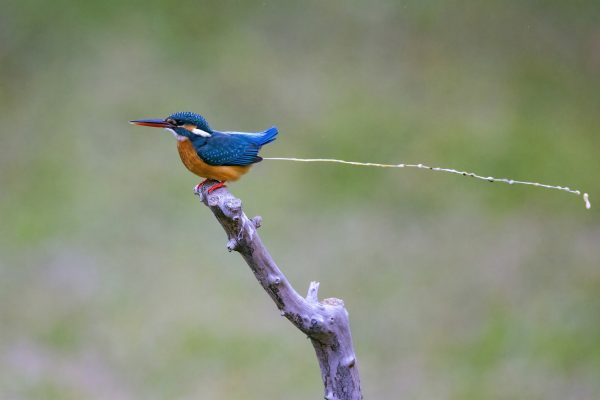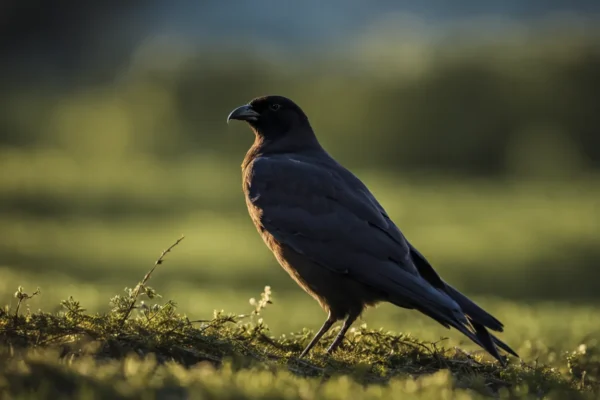In the world of birds, eagles are among the most fearsome predators due to their enormous, strong talons and keen beaks. The harpy and bald eagles are two of the biggest and most striking species of eagles.
For those with limited time, the following is a brief response to your inquiry: The harpy eagle is bigger and stronger than the bald eagle on average.
We’ll examine the size variations between the harpy and bald eagles in-depth in this extensive post. We will measure their overall lengths, weights, leg and talon sizes, and wingspans. We’ll also go over fascinating details on the habitats and hunting prowess of each species.
Length of wings
A bird’s wingspan plays a significant role in determining its ability to fly and its hunting strategies. It is evident by comparing the wingspans of the Bald Eagle and the Harpy Eagle that both species have large wingspan.
Eagle Harpy’s Wingspan
With an average wingspan of about 6 to 7 feet (1.8 to 2.1 meters), the Harpy Eagle is one of the biggest and most powerful eagles in the world. The Harpy Eagle is an exceptionally nimble and proficient predator due to its large wingspan, which enables it to glide effortlessly over the rainforest canopy.
Bald Eagle’s Wing Length
The national bird and emblem of the United States, the Bald Eagle, has a remarkable wingspan as well. Similar to the Harpy Eagle, the Bald Eagle typically has a wingspan of 6 to 7.5 feet (1.8 to 2.3 meters).
The Bald Eagle’s large wingspan enables it to fly beyond its natural environment, allowing it to search the land and water below for possible food.
It’s important to remember that both species may have individual variances, with some Bald Eagles and Harpy Eagles having wingspans that are somewhat greater or narrower. On the other hand, their usual wingspan sizes may be inferred from the aforementioned average range.
It is evident by comparing the wingspans of these two magnificent predators that they are of comparable size and have remarkable flight ability. Both the Bald Eagle and the Harpy Eagle have broad wings that allow them to soar through the sky with ease. They hunt by using air currents and thermals to save energy.
Look into All About Birds and Audubon if you’d want to know more about these amazing birds and their wingspans.
Mass
An important factor in a bird’s capacity to hunt, fly, and endure in its surroundings is its weight. It’s crucial to remember that although both the bald and harpy eagles are very strong and fearsome predators, there are minor weight disparities between the two species.
Harpy Eagle:
One of the biggest and heaviest eagle species in the world is the harpy eagle. Harpy eagles typically weigh between 6.5 and 9 kg (14 and 20 pounds) for males and between 7.5 and 9 kg (14 and 20 pounds) for females.
They are among the world’s biggest raptors due to their remarkable weights. They are able to control their prey, which is mostly made up of sloths and monkeys, because to their size and weight.
The Bald Eagle
The bald eagle is still a large bird even if it is not as hefty as the harpy eagle. normally, female bald eagles weigh between 4 and 6.8 kilograms (8.8 to 15 pounds), whereas males normally weigh between 3 and 4.5 kilograms (6.6 to 9.9 pounds).
The bald eagle has amazing power and agility in the air, even though it weighs less than the harpy eagle. Its weight enables it to hunt small animals, fish, and ducks while soaring through the air.
Fun fact: The bald eagle is the national bird of the United States and a symbol of freedom and power.
It’s crucial to remember that these weights are averages and that the size and weight of individual birds might vary. These birds’ weight might vary depending on a number of factors, including age, sex, and prey availability.
It’s also important to note that these eagles’ weights might vary based on the area and environment they live in.
Visit the Smithsonian National Zoo website for further information on harpy eagle weight, and the Cornell Lab of Ornithology’s All About Birds page for bald eagle weight.
Size of Legs and Talon
One obvious distinction between the bald and harpy eagles is the size of their talon and legs. The legs of the harpy eagle, which is renowned for having enormous, strong legs, may grow up to 5 inches in diameter.
The harpy eagle’s very powerful legs enable it to seize and transport prey that is considerably bigger than it. The harpy eagle can readily take up monkeys, sloths, and other animals from the trees because to its enormous legs.
The bald eagle, on the other hand, has comparatively smaller legs, with a diameter of two to three inches. The bald eagle’s legs can still grab fish and small animals, despite not being as large as the harpy eagle’s.
In contrast, their talons, which are around two inches long, are strong and pointed. These talons are ideal for seizing their prey and rendering it motionless.
In contrast:Tail Diameter of the Bald Eagle: Up to 5 inchesbetween two and three inches
Talon Length: N/A Approximately 2 in.
The harpy eagle has an edge over other eagles in hunting bigger prey due to its longer legs, whereas the bald eagle is better at fishing and hunting smaller animals because of its smaller legs and sharper talons.
The proportions of their legs and talon have been modified by both species to fit their unique hunting requirements and habitats.
Fun Fact: The harpy eagle has been known to pluck tiny deer from the forest floor and transport them away due to its amazing leg strength!
Visit National Geographic and Audubon for further information about bald and harpy eagles.
Measurements of Length and Height
Both the Bald Eagle and the Harpy Eagle are remarkable animals in their own way when it comes to size.
The world’s biggest and most formidable predatory bird is the harpy eagle, which is renowned for its enormous size. A mature Harpy Eagle’s length ranges from 35 to 41 inches (89 to 104 cm), which is significantly less than that of its counterpart, the Bald Eagle.
In terms of length, the Bald Eagle—the national bird and emblem of the United States—is somewhat bigger than the Harpy Eagle. A mature Bald Eagle’s length usually ranges from 36 to 42 inches (91 to 107 cm).
It’s crucial to remember that both species have individual variances, and there can be some overlap in the length measures.
Comparison of Height
The Harpy Eagle is renowned for its remarkable stature in terms of height. Standing between 3.3 and 3.9 feet (1 and 1.2 meters) tall, it is taller than the typical adult human. Its enormous talons and long legs, which it uses to catch and transport prey, are said to be the reason for its height.
In contrast to the Harpy Eagle, the Bald Eagle is somewhat smaller in height. Its normal height is between 2.5 and 3.5 feet (0.76 and 1.07 meters). The Bald Eagle’s enormous wingspan and strong beak enable it to make up for its somewhat smaller height, which helps it to excel at fishing and hunting.
Comparing the lengths and heights of these magnificent predators is intriguing because it highlights their distinctive features and adaptations for surviving in their different environments.
You may go to the following websites to learn more about the dimensions of these amazing birds:
Size of Skull
The remarkable cranial features of the Bald Eagle and the Harpy Eagle, when compared in size, demonstrate how these predators’ power and hunting prowess are influenced by these remarkable skulls.
The skull of the harpy eagle, which is renowned for its enormous size and strength, is around five inches long. Its enormous cranium makes room for its robust jaw muscles and strong beak, which let it easily grasp and subdue prey.
In contrast, the skull size of the Bald Eagle, a representation of power and independence, is somewhat less than that of the Harpy Eagle. Its length is around 4 inches. Even while the size disparity may not seem like much, the Bald Eagle’s power and hunting prowess are nonetheless rather remarkable.
Adaptations of the Skull
These predators’ ability to hunt is influenced by more than just the size of their skulls. Due to specific skull adaptations, both the Bald Eagle and the Harpy Eagle are better able to hunt and live in their particular environments.
With its bigger cranium, the Harpy Eagle’s beak is made especially strong to rip through the hard feathers and skins of its prey. With the help of its strong bite and powerful jaw muscles, it can take down and devour bigger creatures like sloths and monkeys.
Despite having a somewhat smaller skull, the Bald Eagle’s hooked beak is ideal for cutting apart fish, which is its main food source. With the help of its powerful beak and talons, the Bald Eagle can effectively capture and eat fish because to the form of its beak.
Comparison of Species’ Skull Sizes
Eagle Harpy, 5 inches
Four-inch Bald Eagle
It’s crucial to keep in mind that both bald eagles and harpy eagles are very proficient hunters and top predators in their respective regions, despite the harpy eagle’s bigger head.
Because their skull proportions are tailored to meet their unique hunting requirements, they are able to capture and devour their prey with greater efficiency.
See the Birds section of National Geographic for further details on the anatomy and adaptations of birds.
Environments
Although they live in distinct environments, both the Bald Eagle and the Harpy Eagle are magnificent predators.
Habitat of the Harpy Eagle
The lush jungles of Central and South America are home to the harpy eagle. The harpy eagle may flourish in these deep woodlands because of the ideal conditions they provide. They can easily move through the thick undergrowth and canopy because to their enormous size and strong wings.
They often locate their nests next to rivers or other sources of water, high up in the highest trees. Because the harpy eagle depends on the amount of food available in the rainforest environment, its habitat is essential to its existence.
Bald Eagle Environment
In contrast, the Bald Eagle is a common bird in North America, especially in the vicinity of bodies of water like rivers, lakes, and coasts. Because fish are their main food source and are easily accessible from tall trees near water sources, they prefer to nest there.
The habitat of the Bald Eagle is not restricted to any one location; it may be found in woods, mountains, and even places with metropolitan areas. Nonetheless, they are most often connected to coastal areas and huge bodies of water.
Interestingly, the habitat of the Bald Eagle has grown throughout time as a result of conservation initiatives and the outlawing of dangerous pesticides like DDT. Their population has grown as a consequence, and they are now found in places where they were previously rare.
Visit the National Geographic website to learn more about the habitat of the harpy eagle. In a similar vein, the Audubon Society offers insightful information on the habitat of the Bald Eagle.
Hunting Techniques and Prey
The Bald Eagle and the Harpy Eagle are both excellent hunters with strong hunting abilities. Let’s examine their hunting strategies and favorite prey in more detail:
Harpy Eagle:
The eagle is renowned for its outstanding hunting skills. It can take down prey much bigger than itself because to its strong talons and acute vision. These birds hunt mostly in Central and South America’s deep rainforests, where they utilize their dexterity to find their way among the trees.
The sloth is among the harpy eagle’s preferred prey. It can easily grab a sloth by the talons, which are sharp, and pull it off a tree limb. In addition, they consume tiny birds and reptiles, as well as other mammals including opossums and monkeys.
In their natural environment, harpy eagles are regarded as apex predators because of their size and formidable hunting skills. By managing the numbers of their prey, they are essential to preserving the equilibrium of the rainforest environment.
The Bald Eagle
One of the most recognizable raptors in North America is the Bald Eagle. It may not be as large as a harpy eagle, but its exceptional hunting abilities and versatility make up for it.
These eagles are renowned for having keen vision, which enables them to identify prey at a considerable distance. They often sit atop tall trees or cliffs that provide a good view of bodies of water, making it easy for them to see fish that are swimming close to the surface.
A big part of the Bald Eagle’s diet consists of fish. They are expert fishers, and they will dive down and use their strong talons to grab fish out of the water. But since they are opportunistic predators, bald eagles will also consume carrion, small animals, and other birds.
The Bald Eagle’s capacity for food scavenging is very remarkable. They typically scavenge corpses abandoned by bigger predators or take food from other birds, such ospreys. Their capacity to adapt protects their survival, particularly in the winter when fish, which is their main food source, may become rare. Recognized as the top predator in its environment, this opportunistic hunter is skilled in scavenging
Observing how these amazing raptors have tailored their hunting techniques and adapted to their specific environments is interesting. Both species are examples of the amazing variety and beauty of our natural environment, whether they are soaring through the jungle or diving down to capture a fish.
Final Thoughts
In terms of size, the harpy eagle is bigger and more robust than the bald eagle in general. The harpy lives up to its reputation as one of the most dangerous avian predators, with enormous talons that can apply pressure of up to 500 psi and a wingspan over 7 feet.
Still, the bald eagle is a magnificent predator in its own right, particularly in its natural settings in North America.






One thought on “Harpy Eagle Vs. Bald Eagle: A Detailed Comparison”